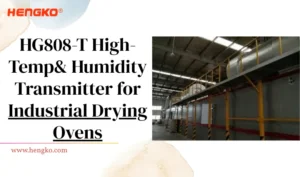
HG808-T High-Temperature Humidity Transmitter for Industrial Drying Ovens
HG808-T High-Temperature Humidity Transmitter for Industrial Drying Ovens In many manufacturing processes, drying is more
Accueil " Transmetteur de température et d'humidité
Choosing the Perfect Industrial Temperature and Humidity Transmitter Monitor: An Extensive Guide to HENGKO’s Range for Optimal Temperature and Humidity Control
HENGKO propose une large gamme de capteurs de température et d'humidité pour tous les besoins, des sondes de température et d'humidité en acier inoxydable aux transmetteurs de point de rosée. Nos capteurs sont précis, fiables et durables, ce qui les rend idéaux pour une large gamme d'applications.
HENGKO offers a wide range of temperature and humidity sensors for every need, from stainless steel temperature and humidity sensor probes to dew point transmitters. Easy wall mounted temperature humidity sensor, Our sensors are accurate, reliable, and durable, making them ideal for a wide range of applications
Tips:
Means You Can Choose RS485 Output if You perfect the transmitter show Show Fahrenheit
Tips:
Means You Can Choose RS485 Output if You perfect the transmitter show Show Fahrenheit
HENGKO propose une large gamme de capteurs de température et d'humidité pour tous les besoins, des sondes de température et d'humidité en acier inoxydable aux transmetteurs de point de rosée. Nos capteurs sont précis, fiables et durables, ce qui les rend idéaux pour une large gamme d'applications.
Tips:
Means You Can Choose RS485 Output if You perfect the transmitter show Show Fahrenheit
Tips:
Means You Can Choose RS485 Output if You perfect the transmitter show Show Fahrenheit
HENGKO propose une large gamme de capteurs de température et d'humidité pour tous les besoins, des sondes de température et d'humidité en acier inoxydable aux transmetteurs de point de rosée. Nos capteurs sont précis, fiables et durables, ce qui les rend idéaux pour une large gamme d'applications.
HENGKO propose une large gamme de capteurs de température et d'humidité pour tous les besoins, des sondes de température et d'humidité en acier inoxydable aux transmetteurs de point de rosée. Nos capteurs sont précis, fiables et durables, ce qui les rend idéaux pour une large gamme d'applications.
Tips:
Means You Can Choose RS485 Output if You perfect the transmitter show Show Fahrenheit
HENGKO propose une large gamme de capteurs de température et d'humidité pour tous les besoins, des sondes de température et d'humidité en acier inoxydable aux transmetteurs de point de rosée. Nos capteurs sont précis, fiables et durables, ce qui les rend idéaux pour une large gamme d'applications.
Tips:
Means You Can Choose RS485 Output if You perfect the transmitter show Show Fahrenheit
HENGKO propose une large gamme de capteurs de température et d'humidité pour tous les besoins, des sondes de température et d'humidité en acier inoxydable aux transmetteurs de point de rosée. Nos capteurs sont précis, fiables et durables, ce qui les rend idéaux pour une large gamme d'applications.
HENGKO propose une large gamme de capteurs de température et d'humidité pour tous les besoins, des sondes de température et d'humidité en acier inoxydable aux transmetteurs de point de rosée. Nos capteurs sont précis, fiables et durables, ce qui les rend idéaux pour une large gamme d'applications.
Tips:
Means You Can Choose RS485 Output if You perfect the transmitter show Show Fahrenheit
HENGKO propose une large gamme de capteurs de température et d'humidité pour tous les besoins, des sondes de température et d'humidité en acier inoxydable aux transmetteurs de point de rosée. Nos capteurs sont précis, fiables et durables, ce qui les rend idéaux pour une large gamme d'applications.
Tips:
Means You Can Choose RS485 Output if You perfect the transmitter show Show Fahrenheit
HENGKO propose une large gamme de capteurs de température et d'humidité pour tous les besoins, des sondes de température et d'humidité en acier inoxydable aux transmetteurs de point de rosée. Nos capteurs sont précis, fiables et durables, ce qui les rend idéaux pour une large gamme d'applications.
HENGKO propose une large gamme de capteurs de température et d'humidité pour tous les besoins, des sondes de température et d'humidité en acier inoxydable aux transmetteurs de point de rosée. Nos capteurs sont précis, fiables et durables, ce qui les rend idéaux pour une large gamme d'applications.
Tips:
Means You Can Choose RS485 Output if You perfect the transmitter show Show Fahrenheit
Tips:
Means You Can Choose RS485 Output if You perfect the transmitter show Show Fahrenheit
HENGKO offers a wide range of temperature and humidity sensors for every need, from stainless steel temperature and humidity sensor probes to dew point transmitters.
Our sensors are accurate, reliable, and durable, making them ideal for a wide range of applications
Tips:
Means You Can Choose RS485 Output if You perfect the transmitter show Show Fahrenheit
Tips:
Means You Can Choose RS485 Output if You perfect the transmitter show Show Fahrenheit
| No. | Modèle | Type de sonde | Output | Display or Not | Order Model | Probe Name | Plage de température | Operating Temperature | |
| 1 | HG803 | Split Probe | RS485 + Dew Point | No Display | HG803-1W8P-02 | Plastic Probe (waterproof and dustproof) | -40~100℃ | <80℃ | |
| 2 | HG803-1W8P-04 | Standard SS Probe (highly waterproof and dustproof) | -40~120℃ | <110℃ | |||||
| 3 | HG803-1W8P-05 | Hexagonal SS Probe (highly waterproof and dustproof) | -40~120℃ | <110℃ | |||||
| 4 | HG803-1W8P-06 | Short SS Probe SS Probe (highly waterproof and dustproof) | -40~120℃ | <110℃ | |||||
| 5 | HG803-1W8P-07 | Long SS Probe SS Probe (highly waterproof and dustproof) | -40~120℃ | <110℃ | |||||
| 6 | With Display | HG803-2W8P-02 | Plastic Probe (waterproof and dustproof) | -40~100℃ | <80℃ | ||||
| 8 | HG803-2W8P-04 | Standard SS Probe (highly waterproof and dustproof) | -40~120℃ | <110℃ | |||||
| 9 | HG803-2W8P-05 | Hexagonal SS Probe (highly waterproof and dustproof) | -40~120℃ | <110℃ | |||||
| 10 | HG803-2W8P-06 | Short SS Probe SS Probe (highly waterproof and dustproof) | -40~120℃ | <110℃ | |||||
| 11 | HG803-2W8P-07 | Long SS Probe SS Probe (highly waterproof and dustproof) | -40~120℃ | <110℃ | |||||
| 12 | RS485 + 4-20mA | No Display | HG803-1W4P-02 | Plastic Probe (waterproof and dustproof) | -40~100℃ | <80℃ | |||
| 14 | HG803-1W4P-04 | Standard SS Probe (highly waterproof and dustproof) | -40~120℃ | <110℃ | |||||
| 15 | HG803-1W4P-05 | Hexagonal SS Probe (highly waterproof and dustproof) | -40~120℃ | <110℃ | |||||
| 16 | HG803-1W4P-06 | Short SS Probe SS Probe (highly waterproof and dustproof) | -40~120℃ | <110℃ | |||||
| 17 | HG803-1W4P-07 | Long SS Probe SS Probe (highly waterproof and dustproof) | -40~120℃ | <110℃ | |||||
| 18 | With Display | HG803-2W4P-02 | Plastic Probe (waterproof and dustproof) | -40~100℃ | <80℃ | ||||
| 20 | HG803-2W4P-04 | Standard SS Probe (highly waterproof and dustproof) | -40~120℃ | <110℃ | |||||
| 21 | HG803-2W4P-05 | Hexagonal SS Probe (highly waterproof and dustproof) | -40~120℃ | <110℃ | |||||
| 22 | HG803-2W4P-06 | Short SS Probe SS Probe (highly waterproof and dustproof) | -40~120℃ | <110℃ | |||||
| 23 | HG803-2W4P-07 | Long SS Probe SS Probe (highly waterproof and dustproof) | -40~120℃ | <110℃ | |||||
| 24 | Split Probe (Replaceable) | RS485 + Dew Point | No Display | HG803-7W8P-02 | Standard Split Probe (replaceable waterproof and dustproof plastic probe) | -40~100℃ | <80℃ | ||
| 26 | With Display | HG803-8W8P-02 | Standard Split Probe (replaceable waterproof dustproof plastic probe) | -40~100℃ | <80℃ | ||||
| 27 | RS485 + 4-20mA | No Display | HG803-7W4P-02 | Standard Split Probe (replaceable waterproof dustproof plastic probe) | -40~100℃ | <80℃ | |||
| 28 | With Display | HG803-8W4P-02 | Standard Split Probe (replaceable waterproof and dustproof plastic probe) | -40~100℃ | <80℃ | ||||
| 29 | Integrated Probe | RS485 + Dew Point | No Display | HG803-5C8P-01 | Plastic Split Probe ( replaceable waterproof dustproof plastic probe) | -40~100℃ | -20 ~ 60℃ | ||
| 30 | With Display | HG803-6C8P-01 | Plastic Split Probe ( replaceable waterproof dustproof plastic probe) | -40~100℃ | -20 ~ 60℃ | ||||
| 31 | RS485 + 4-20mA | No Display | HG803-5C4P-01 | Plastic Split Probe ( replaceable waterproof dustproof plastic probe) | -40~100℃ | -20 ~ 60℃ | |||
| 32 | With Display | HG803-6C4P-01 | Plastic Split Probe ( replaceable waterproof dustproof plastic probe) | -40~100℃ | -20 ~ 60℃ | ||||
| 33 | Integrated Probe ( Duct Type) | RS485 + Dew Point | No Display | HG803-3W8P-12 | Plastic flange air duct probe | -40~80℃ | <110℃ | ||
| 34 | HG803-3W8P-08 | SS 15 flange air duct probe | |||||||
| 35 | HG803-3W8P-09 | SS 15 thread air duct probe | |||||||
| 36 | HG803-3W8P-10 | SS 20 flange air duct probe | |||||||
| 37 | HG803-3W8P-11 | SS 20 thread air duct probe | |||||||
| 38 | With Display | HG803-4W8P-12 | Plastic flange air duct probe | ||||||
| 39 | HG803-4W8P-08 | SS 15 flange air duct probe | |||||||
| 40 | HG803-4W8P-09 | SS 15 thread air duct probe | |||||||
| 41 | HG803-4W8P-10 | SS 20 flange air duct probe | |||||||
| 42 | HG803-4W8P-11 | SS 20 thread air duct probe | |||||||
| 43 | RS485 4-20mA | No Display | HG803-3W4P-12 | Plastic flange air duct probe | |||||
| 44 | HG803-3W4P-08 | SS 15 flange air duct probe | |||||||
| 45 | HG803-3W4P-09 | SS 15 thread air duct probe | |||||||
| 46 | HG803-3W4P-10 | SS 20 flange air duct probe | |||||||
| 47 | HG803-3W4P-11 | SS 20 thread air duct probe | |||||||
| 48 | With Display | HG803-4W4P-12 | Plastic flange air duct probe | ||||||
| 49 | HG803-4W4P-08 | SS 15 flange air duct probe | |||||||
| 50 | HG803-4W4P-09 | SS 15 thread air duct probe | |||||||
| 51 | HG803-4W4P-10 | SS 20 flange air duct probe | |||||||
| 52 | HG803-4W4P-11 | SS 20 thread air duct probe | |||||||
HENGKO est un fournisseur professionnel de solutions de capteurs industriels de température et d'humidité, réputé pour son design unique et ses excellentes performances.
Our temperature and humidity transmitter and sensor are used in a wide range of industries, including food and beverage, pharmaceutical, manufacturing, and environmental monitoring.
Vous pouvez personnaliser entièrement un produit unique de capteur de point de rosée basé sur notre série de transmetteurs de point de rosée brevetés et conçus par nos soins.
Vous obtiendrez des prix beaucoup plus bas et compétitifs grâce à notre contrôle extrêmement rentable.
Grâce à nos produits en constante évolution, vous répondrez toujours aux besoins du marché en constante évolution.
Vous bénéficierez d'un soutien marketing solide pour vous aider à vendre vos produits avec succès. Les supports matériels comprennent : des images de produits en haute résolution, des vidéos à effet 3d, et bien plus encore.










If you’re keen on collaborating with HENGKO as an Agent for our Temperature and Humidity Sensor Products, we warmly invite you to contact us to discuss the specifics. Many exclusive opportunities await you.
An industrial temperature and humidity transmitter is a rugged electronic device designed to measure and transmit both temperature and relative humidity (RH) in harsh industrial environments.
Normally, It plays a crucial role in various industrial processes and applications by providing accurate and reliable data on these two critical parameters.
Sensing: The transmitter uses dedicated sensors for both temperature and humidity. These sensors can be various types depending on the specific model and desired accuracy.
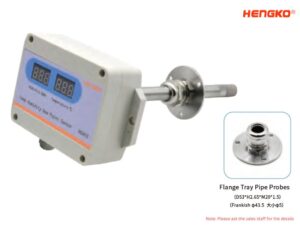
Signal Processing: The sensed temperature and humidity values are converted into electrical signals by the transmitter’s internal circuitry. This may involve amplification, filtering, and conversion to digital formats for further processing.
Data Transmission: The processed data is then transmitted to a central control system, recorder, or other devices. This can be done through various communication protocols, including analog (4-20 mA current loop), digital (RS-485, Modbus), or wireless (Wi-Fi, Bluetooth).
By understanding the working principle, applications, and selection criteria of industrial temperature and humidity transmitters, you can choose the right device for your specific needs and ensure optimal performance and control in your industrial processes.
Industrial temperature and humidity transmitters are essential tools for monitoring and controlling critical environmental parameters in harsh industrial settings.
Those Special features play a crucial role in ensuring process efficiency, product quality, and safety in various industries. Here are some of key features details, please check :
Considerations when Choosing an Industrial Temperature and Humidity Transmitter:
By understanding these key features and considerations, you can select the right industrial temperature and humidity transmitter for your specific needs and ensure optimal performance in your industrial operations.
There are several types of industrial temperature and humidity transmitters, each with its own strengths and weaknesses. The best choice for you will depend on your specific needs and applications. Here are some of the most common types:
By understanding the different types of industrial temperature and humidity transmitters and considering your specific needs, you can make an informed decision and choose the ideal one for your application
The importance of industrial temperature and humidity transmitters stems from their crucial role in maintaining optimal conditions for various processes, products, and environments within diverse industries. Here’s why these seemingly simple devices pack a big punch:
In conclusion, industrial temperature and humidity transmitters are not just instruments; they are critical players in ensuring efficient, safe, and sustainable operations across various industries.
Their impact extends beyond mere data, influencing product quality, employee well-being, and even the environment.
I hope this information highlights the importance of these seemingly simple yet powerful devices!
Selecting the right industrial temperature and humidity transmitter for your project requires careful consideration of various factors. Here’s a guide to help you make the best choice:
The 4-20mA output is a popular choice for dew point sensors because it is a standard industrial output that is compatible with a wide range of control systems. It is also a very reliable and noise-resistant output, which makes it well-suited for use in harsh industrial environments.
Here are some of the advantages of using a 4-20mA output for dew point sensors:
Compatibilité : The 4-20mA output is compatible with a wide range of control systems, including PLCs, DCSs, and SCADA systems. This makes it easy to integrate dew point sensors into existing control systems.
Fiabilité : The 4-20mA output is a very reliable output that is not susceptible to noise interference. This is important for dew point sensors, which are often used in harsh industrial environments.
Précision : The 4-20mA output can provide accurate measurements of dew point. This is important for applications where precise dew point control is required.
Gamme : The 4-20mA output can cover a wide range of dew point values. This makes it suitable for a variety of applications.
Coût : The 4-20mA output is a relatively inexpensive output to implement. This makes it a cost-effective option for dew point sensors.
In addition to the advantages listed above, the 4-20mA output is also a very versatile output. It can be used to transmit a variety of other parameters, such as temperature, pressure, and flow rate. This makes it a valuable output for a wide range of industrial applications.
Here are some examples of applications where dew point sensors with 4-20mA outputs are commonly used:
Compressed air systems: Dew point sensors are used in compressed air systems to monitor and control the moisture content of the air. This is important for preventing corrosion and other damage to equipment.
HVAC systems: Dew point sensors are used in HVAC systems to control the humidity levels in buildings. This is important for human comfort and health.
Industrial drying processes: Dew point sensors are used in industrial drying processes to monitor and control the moisture content of the product being dried. This is important for ensuring the quality of the product.
Food and beverage processing: Dew point sensors are used in food and beverage processing to control the moisture content of the product being processed. This is important for ensuring the safety and quality of the product.
Surveillance de l'environnement : Dew point sensors are used in environmental monitoring stations to track changes in moisture content in the atmosphere. This information can be used to forecast weather conditions and to identify potential environmental problems.
As you can see, dew point sensors with 4-20mA outputs are a valuable tool for a wide range of industrial applications. They are reliable, accurate, and versatile, and they can be easily integrated into existing control systems.
The price of dew point transmitters can vary depending on the manufacturer, the features, and the accuracy of the transmitter. In general, dew point transmitters with higher accuracy and more features will cost more than dew point transmitters with lower accuracy and fewer features.
Based on my research, I would say that the price of dew point transmitters is generally fair. The cost of the components and the labor required to manufacture dew point transmitters is high, and the companies that manufacture dew point transmitters need to recoup these costs in order to stay in business. Additionally, dew point transmitters are used in a variety of critical applications, so it is important that they are reliable and accurate. The high price of dew point transmitters reflects the fact that they are high-quality instruments that can be trusted to provide accurate measurements.
Here are some factors that can affect the price of a dew point transmitter:
Here is a table of the price range of dew point transmitters on the market:
| Type | Price Range |
|---|---|
| Chilled mirror | $2,000 – $10,000 |
| Polymer | $500 – $2,000 |
| Metal oxide | $500 – $1,500 |
As you can see, the price range of dew point transmitters can vary depending on the type of transmitter. Chilled mirror dew point transmitters are the most expensive type of transmitter, but they are also the most accurate. Polymer and metal oxide dew point transmitters are less expensive, but they are also less accurate.
The price of dew point transmitters can also vary depending on the features of the transmitter. For example, dew point transmitters with data logging, alarm setpoints, and remote access capabilities will typically cost more than dew point transmitters with fewer features.
If you are looking for a high-quality dew point transmitter, I would recommend purchasing one from a well-known brand that has a good reputation for quality and reliability. You should also consider the features that are important to you and the accuracy that you require. If you are not sure which dew point transmitter is right for you, I would recommend consulting with a professional who can help you make an informed decision.
Quelques questions sur le point de rosée, le transmetteur et le capteur que vous et les gens aiment savoir
A temperature and humidity transmitter is a device that electronically measures both the temperature and relative humidity (RH) in the air. It then transmits this data to a central control system, recorder, or other devices for monitoring and analysis.
1. Sensing: The transmitter has dedicated sensors for both temperature and humidity. Depending on the model and desired accuracy, different sensor types can be used:
2. Signal Processing: The sensed temperature and humidity values are converted into electrical signals by the transmitter’s internal circuitry.
3. Data Transmission: The processed data is then transmitted to a central control system, recorder, or other devices. This can be done through various communication protocols, including analog (4-20 mA current loop), digital (RS-485, Modbus), or wireless (Wi-Fi, Bluetooth).
These transmitters are used in various settings, including:
Using these transmitters offers various advantages:
When selecting one, consider these factors:
By understanding the working principle, applications, and selection criteria of temperature and humidity transmitters, you can choose the right one for your specific needs and ensure optimal performance in your projects.
I hope this comprehensive explanation helps !
Let me know and contact us by email sales@hengkometer.com if you have any further questions.
There are several types of humidity sensors, each using a different physical principle to measure the amount of moisture in the air. Here are the three most common types:
By understanding the different types of humidity sensors and their characteristics,
you can choose the right one for your specific project or application.
A relative humidity and temperature transmitter is an electronic device that measures both the temperature and relative humidity (RH) of the surrounding air and transmits this data electronically to a central control system, recorder, or other devices for monitoring and analysis.
Sensing: The transmitter has dedicated sensors for both temperature and humidity. Depending on the specific model and desired accuracy, different types of sensors can be used:
Signal Processing: The sensed temperature and humidity values are converted into electrical signals by the transmitter’s internal circuitry. This may involve amplification, filtering, and conversion to digital formats for further processing.
Data Transmission: The processed data is then transmitted to a central control system, recorder, or other devices. This can be done through various communication protocols, including analog (4-20 mA current loop), digital (RS-485, Modbus), or wireless (Wi-Fi, Bluetooth).
These transmitters are used in various settings, including:
When selecting one, consider these factors:
By understanding the working principle, applications, and selection criteria of relative humidity and temperature transmitters, you can choose the right one for your specific needs and ensure optimal performance in your projects.
Temperature and humidity transmitters with a 4-20 mA output are widely used in various applications for several reasons:
Overall, temperature and humidity transmitters with a 4-20 mA output remain a popular choice due to their simplicity, reliability, versatility, and cost-effectiveness.
They are well-suited for a wide range of applications where basic analog data transmission and compatibility with existing infrastructure are priorities.
High-temperature humidity transmitters play a crucial role in various applications where both high temperatures and accurate humidity measurements are critical. Here are some examples:
When selecting a transmitter for high-temperature applications, consider these factors:
By understanding the applications and selection criteria for high-temperature humidity transmitters, you can choose the right one for your specific needs and ensure optimal performance in your high-temperature environment.
If you have any further questions about specific applications or choosing the right transmitter, feel free to ask!
The comfortable dew point range for most people is between 40°F (4°C) and 60°F (15°C). Below 40°F, the air can feel dry and uncomfortable. Above 60°F, the air can feel humid and uncomfortable.
There are two main ways to monitor dew point using a temperature and humidity transmitter:
Industrial temperature and humidity sensors offer a variety of output options to cater to different needs and existing infrastructure. Here’s a breakdown of the most common types:
By understanding the available output options and your specific needs, you can choose the best solution for your industrial temperature and humidity sensor applications.
I hope this information helps!
Feel free to ask if you have any further questions.
Humidity and temperature sensors play a crucial role in modern HVAC systems, contributing to improved comfort, efficiency, and safety. Here’s a closer look at their applications:
Choosing the right sensor type and location depends on your specific needs and HVAC system configuration.
By taking advantage of these versatile sensors, HVAC systems can deliver a more comfortable, efficient, and safe environment for all.
I hope this comprehensive overview helps you understand the valuable applications of humidity and temperature sensors in HVAC systems!
Feel free to ask if you have any further questions about specific applications or sensor types.
Contactez HENGKO dès aujourd'hui pour toute question concernant les capteurs de température et d'humidité, les transmetteurs et les solutions.

HG808-T High-Temperature Humidity Transmitter for Industrial Drying Ovens In many manufacturing processes, drying is more
Le rôle de la surveillance de la température et de l'humidité Les transmetteurs de température et d'humidité sont des outils essentiels pour
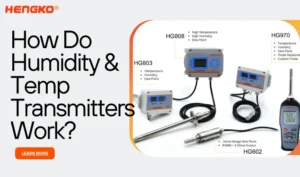
En bref, les transmetteurs d'humidité et de température mesurent et envoient des données environnementales aux systèmes de contrôle. Ils sont
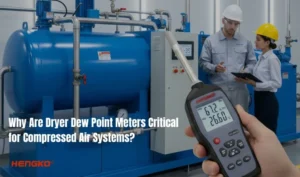
Pourquoi les appareils de mesure du point de rosée des sécheurs sont-ils essentiels pour les systèmes d'air comprimé ? Peut-être que vous vous battez toujours

Pourquoi une zone de bureau est trop humide et comment un transmetteur d'humidité y remédie Persistant
Contactez notre équipe d'experts pour une assistance personnalisée et nous vous fournirons rapidement les meilleures solutions de transmetteurs et de capteurs de température et d'humidité adaptées à vos besoins spécifiques.

Laissez-nous vous expliquer pourquoi vous devriez choisir un transmetteur de point de rosée
de HENGKO
La réponse est simple : HENGKO est différent.
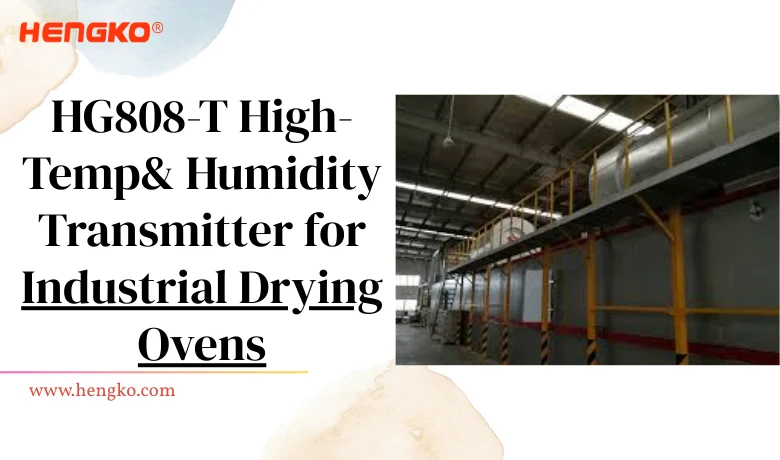
HG808-T High-Temperature Humidity Transmitter for Industrial Drying Ovens In many manufacturing processes, drying is more than just a step — it’s a decisive factor that

HG808-T High-Temperature Humidity Transmitter for Industrial Drying Ovens In many
Le rôle de la surveillance de la température et de l'humidité La température et l'humidité
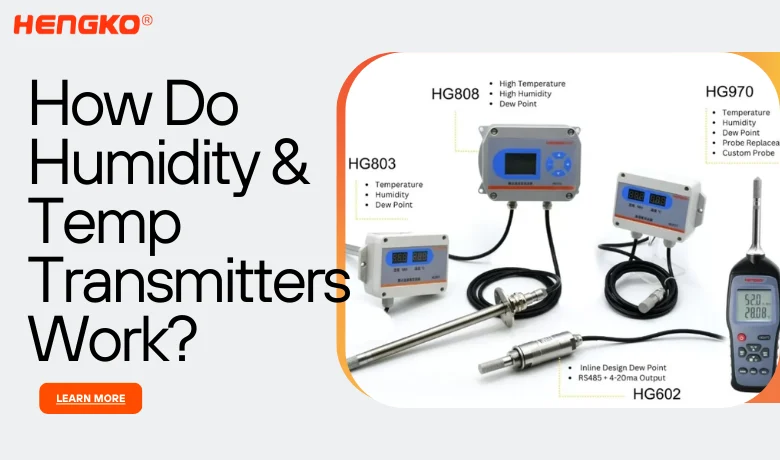
En bref, les transmetteurs d'humidité et de température mesurent et envoient des informations sur l'environnement.
Nous contacter par WhatsApp